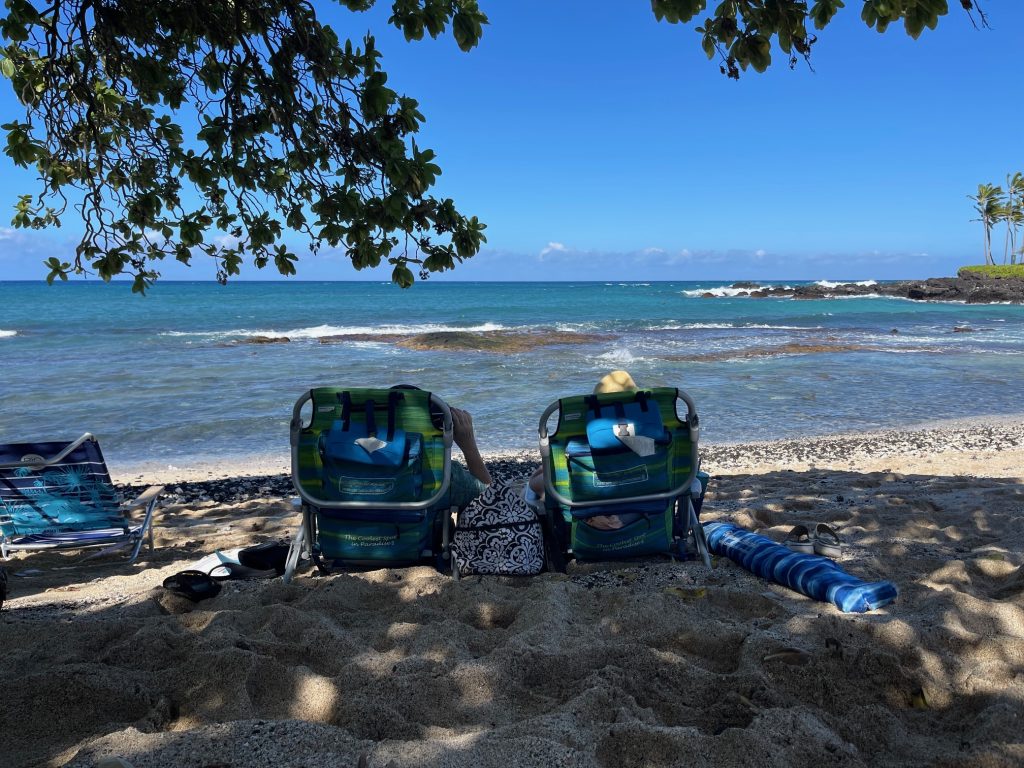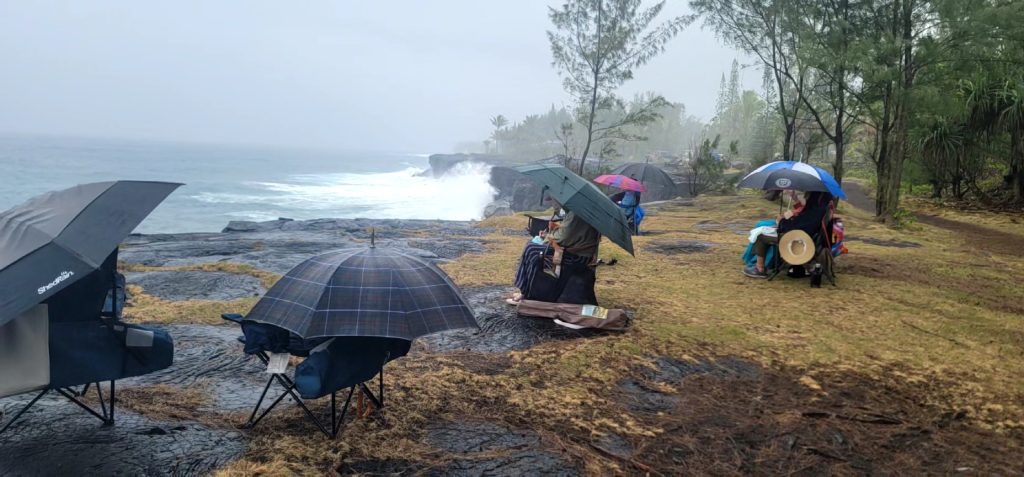Volunteers become citizen scientists to help humpback whale conservation efforts

Mike Kano of Hanamāʻulu became a volunteer on Kauaʻi for the Sanctuary Ocean Count by the Hawaiian Islands Humpback Whale National Marine Sanctuary volunteer 17 years ago as a project for Boy Scout Troop 133, for which he was Scoutmaster.
It’s one of two annual counts that help provide a snapshot in time of humpback whale trends in Hawaiʻi waters.
Kano continued volunteering after the troop’s project was finished because of his interest in koholā, or humpback whales. The 76-year-old has now been the site leader for the past 13 years at the Līhuʻe count location outside the Nawiliwili Harbor entrance.
Count days are a highlight of the year for him.
“You don’t see very much of them, but when you do see, and you know the blows and the slaps are all OK, but the breaches and their kind of interaction with each other, even though you only see a little portion of it, it’s interesting,” said Kano. “Then, most of the time you see them offshore, but sometimes they come in close to shore. So that’s a time when it’s really interesting.”
He’s one of the hundreds of citizen scientists who on the last Saturdays of January, February and March each year head to the shores of every main Hawaiian island, except Kahoʻolawe, to watch for signs of humpbacks as part of the Sanctuary Ocean Count and the Great Whale Count by the Pacific Whale Foundation.
The Sanctuary Ocean Count covers the Big Island, Kauaʻi, Molokaʻi and Oʻahu while the Great Whale Count is done on Maui and Lānaʻi.
Both are long-time survey efforts conducted during peak whale season in Hawaiʻi. They have been synced on the same days for the past 6 years so data can be collected simultaneously.
From 8 a.m. to noon on those three Saturdays, volunteers survey the sea from more than 40 sites throughout the state, including 10 active sites on the Big Island and 10 on Kauaʻi. They also record the whales’ surface behavior, including blow spouts when the animals come up to breathe, pectoral fin slaps, tail slaps and awe-inspiring breaches.

On Feb. 24, the second of this year’s three count days, volunteers tallied a statewide total of 2,141 humpback sightings, including 466 in Big Island waters and 239 off Kauaʻi. On Jan. 27, a total of 2,124 sightings were recorded, with 324 off Hawaiʻi Island and 292 in waters around Kauaʻi.
The highest number Kano counted during a 15-minute span Jan. 27 was 15 and he observed 3 last Saturday.
Kano said January was pumping: “That was probably the most whales I saw in January for at least several years.”
During the January 2023 count day, volunteers observed a total of 587 humpback whales throughout the state. A total of 997 koholā were observed throughout the islands during last year’s February count day.
Suzy Lauer of Hilo on the Big Island is a site leader for the Onekahakaha Beach Park count location in Hilo. She said her group observed about 20 whale sightings last weekend and 26 in January. The Onekahakaha volunteers even watched Feb. 24 as one whale did 30-some tails slaps.
“It was just hysterical,” Lauer said. “We just couldn’t believe it kept going.”
Those numbers, however, could include duplicate sightings by different observers or at different times or locations throughout the day.
Several other species were also observed during this year’s January and February counts, such as honu, or green sea turtles; ʻilioholoikauaua, or Hawaiian monk seals; naiʻa, or spinner dolphins; hāhālua, or manta ray; and birds including ʻiwa, or the great frigatebird; mōlī, or Laysan albatross; nēnē, the Hawaiian goose; ʻā, or the brown booby; kōlea, or Pacific golden plover; and more.
The third and final count day is scheduled for March 30.
For more past data, including from separate sites, click here.
The annual counts engage the public by allowing the community to contribute to ongoing monitoring of the marine mammals that migrate 3,000 miles every winter from waters around Alaska, Canada and even Russia to Hawai’i waters to mate, calve and nurse their young.
“We can connect with hundreds of volunteers each time we do this event,” said Jens Currie, chief scientist for the Pacific Whale Foundation on Maui. “It’s important to get people involved in research, to get passionate about the study of species, in this case, humpback whales, because that often leads to caring about those species, and that potentially leads to support for conservation.”
Humpback whales, including the distinct population of humpbacks that comes to Hawaiʻi, haven’t been considered endangered under the federal Endangered Species Act since 2016. However, that doesn’t mean conservation efforts have ceased.
Currie said there’s still work to do so the humpback population continues its recovery and the upward trajectory seen during the past 40 years since the whaling era ended. Despite a decline in numbers in 2015 and 2016, the population has rebounded since.
Lauer’s been told it’s estimated that about 10,000 to 12,000 humpbacks pass through the Hawaiian islands every year.
The annual counts, both about 30 years old, provide data important to population monitoring efforts.
The shoreline census information the whale watching volunteers collect is consistent and comparable to more robust efforts by scientists conducting population surveys and other research three or four times a day for 7 or 8 hours.
“It’s complementary, but it can’t be replaced,” Currie said.
He added the counts are unique in that volunteers have eyes on the water throughout the entire state all at the same time, all counting whales, unlike researchers who often focus on a particular area, meaning the coverage isn’t as wide or concise as the counts.

For Lauer, participating in the counts is her way of contributing to the care of koholā, or humpbacks.
“I felt that it was something that I could do to get the information to the people that need to know what’s happening,” said Lauer, adding that in the early 1980s, the whales were never seen in Hilo waters. “Now they’re here and people need to know how many are here.”
With more whales in the water and a high number of ocean users, threats to humpbacks still exist, such as the animals becoming entangled in netting or other materials and being struck by vessels.
Even global warming is having an impact on the whales as ocean temperatures rise and cause problems with food sources. The warmer waters also could have an impact on breeding and calving grounds around Hawai‘i as temperatures climb above what the animals prefer.
The more the public is aware of the issues and engaged, the better organizations aimed at protecting them can do their jobs.
Currie said the ocean counts can provide key early indicators if something is wrong with the humpback population and a closer look is needed, triggering more dedicated research.
“We’re sharing the environment, the ocean is their home,” he said. “So anytime we’re on the water, we need to be aware if the humpback whales are around here.”
Currie said you can’t undervalue getting the public engaged in some form of science to raise awareness, which is another goal of the counts. Many site leaders also are researchers, who talk with their volunteers about the latest science and connect with the community to share their findings.
Even site leaders who aren’t researchers, such as Lauer, talk with the other volunteers at their sites about whales, educating them by sharing stories and facts during times when there’s nothing to observe.
“It’s really just community engagement and just a really solid community science project,” Currie said.
To be able to go down to the beach and sit and watch the magnificent creatures — any time of day now — is special to Lauer and gives her hope for the future of the humpback species. It also makes her feel good that she is playing a part in helping the whales.
“You can bring a species back from the edge, and I think the data that we’ve taken and passed on contributes to that,” Lauer said, adding if the count didn’t exist, she’s not sure if the whales would have been taken off the endangered list.
Lauer hopes more volunteers come onboard so more of the Big Island’s 22 ocean count sites can become active and more data can be provided.
“You can contribute,” she said. “You can sit on your couch just as easy as you can sit in a beach chair, so come down, have sunshine, have the waves, the salt air and count the whales.”
There could be some spots that open up to volunteer during the final count day at the end of March. Anyone who wants to volunteer can check online.
For more information about the Hawaiian Islands Humpback Whale National Marine Sanctuary Ocean Count, click here. For more information about the Great Whale Count by the Pacific Whale Foundation, click here.









